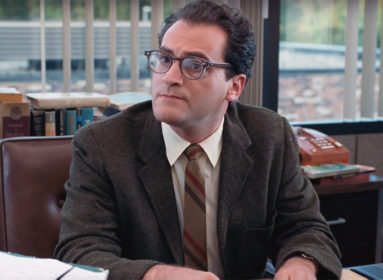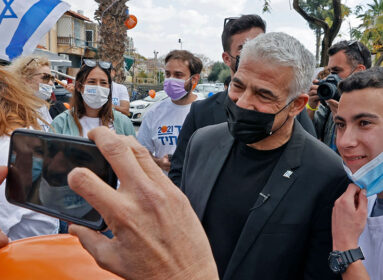According to a 2013 study by U.S. News & World Report, as many as a third of first-year college students don’t return for sophomore year. Among the reasons cited – family problems, homesickness, academic challenges, and financial struggles – is a simple truth: many 18-year-olds aren’t ready to live on their own and focus on a direction.
Many top U.S. universities recommend in their acceptance letters that students delay the start of college by taking a gap year; Princeton has developed its own Bridge Year Program to allow pre-freshmen to engage in a nine-month service project at one of five international locations.
Now a popular option for many recent North American high-school graduates, the gap year – usually based in Israel – has long been part of the curriculum of several Jewish youth movements in the U.S. and Canada. A survey exploring the link between service-learning experiences in Israel and commitment to Jewish communal engagement was recently released by Repair the World, a U.S. non-profit organization, in conjunction with the Jewish Agency for Israel. “Serving a Complex Israel: A Report on Israel-based Immersive Jewish Service-Learning” shows that exposing young Jews to the complex issues underlying Israeli society increases their commitment to the country and motivates them to want to work towards social change in Israel.
“When it comes to developing service programs, authenticity is key,” says David Eisner, CEO of Repair the World. “The more people understand about their service, the more committed they will be to it. What’s more, we know that young people – particularly those from affiliated households – become more passionate when their service brings a connection to their own personal heritage.”
The study, conducted by Rosov Consulting, LLC and funded in part by the Jim Joseph Foundation and The Morningstar Foundation, surveyed 332 young Jewish adults who participated in at least one of 12 different immersive Jewish service-learning programs in Israel from August 2009 to June 2012. Responses showed that there is a widespread desire among millennial Jewish adults to create change in the world, while simultaneously growing as leaders and connecting to Jewish life. Immersive Jewish service-learning programs in Israel provide young adults with that opportunity.
Following is a sampling of Israel-based gap-year programs, as well as input from a few Connecticut students who participated in some of these gap year programs. To learn about other gap year programs in Israel, visit www.masa.org. In addition, the different denominations each sponsor gap year programs in Israel; learn more about them through your synagogue or by visiting the denomination’s website.
Grande Dame: Habonim Dror Workshop
Habonim Dror (“The Builders of Freedom”) is an international progressive Jewish Labor Zionist youth movement, the result of two organizations founded in Europe during the first quarter of the 20th century that merged in 1982. Habonim Dror North America (HDNA) is a progressive Zionist youth movement, born out of the Poalei Tzion movement with a historical relationship to the United Kibbutz Movement (TAKAM).
For over 60 years, HDNA has been running Workshop, a nine-month gap year program that is the oldest Israel-based gap-year program offered by a North American organization. Most participants are former campers and current counselors at one of seven Habonim Dror summer camps throughout the U.S. and Canada, where they spend several years learning leadership and community-building skills. The kibbutz and Irbutz (urban kibbutz)-based work-study program focuses on collective education and dialogue meant to inspire participants to take on leadership roles within the Habonim Dror movement and the Jewish community at large, during college and beyond.
Participants live collectively in small groups on a kibbutz and travel throughout Israel while learning Hebrew and the history of Israel and the Jewish people. They then spend the second half of the program living in Israeli communities and volunteering in schools and youth programs. They also visit Holocaust-related sites in Poland to better understand the Shoah and the role of post-World War II Jewish youth movements in building modern Israel.
“Workshoppers” return from Israel in time to serve as staff at Habonim Dror summer camps.
For more information: www.habonimdror.org
Biggest of the bunch: Young Judaea Year Course
Young Judaea Year Course in Israel is the largest gap-year program for recent high-school graduates. Participants are immersed in all aspects of Israeli life and culture – learning Hebrew, interacting with Israeli peers, developing an appreciation for their Jewish heritage, and exploring Israel through a variety of volunteer placements, travel, and accredited college-level courses.
Established in 1956, Year Course is designed to help participants strengthen their personal and Jewish identities, commitment to Israel, and leadership skills. It encompasses a range of options built around particular interests like arts, business, travel, volunteering, academics, and religious experiences.
All Year Course participants spend time in Jerusalem and Bat Yam, and in a third location of their choice. Each location provides exposure to various aspects of Israeli history, different environments, and a range of cultural communities. While in each location, participants take part in formal and/or informal study, improve their Hebrew-language skills, and work on volunteer projects.
During the “Israel Experience” component of Year Course,
participants choose an immersive experience, training in first-aid care with Magen David Adom, working with under-served children in the Yemin Orde Youth Village, or volunteering and going through basic training on a military base.
For more information: www.yearcourse.org
Potpourri: Masa Israel Journey
Founded in 2003, Masa is an umbrella organization of long-term gap year, study abroad, and post-graduate programs in Israel for Jewish young adults.
Conceived by Israeli Prime Minister Ariel Sharon, Masa Israel was officially established in 2004 as a joint project of the government of Israel and the Jewish Agency for Israel (JAFI). Masa Israel is governed by a 16-member steering committee, with eight representatives of the Government of Israel and eight JAFI representatives. The steering committee is co-chaired by the Government of Israel Cabinet Secretary and the Director General of the JAFI Education Department.
Independent organizations apply to be recognized by Masa Israel, and must include an educational curriculum, Hebrew instruction, and trips around Israel. Organizers include academic institutions like the Hebrew University of Jerusalem and Ben Gurion University of the Negev, Jewish youth movements including Young Judaea and Habonim Dror, yeshiva and seminary programs, and tour providers like The Israel Experience Ltd., Israel Way – Oranim Project and IsraelExperts.
A gap year in Israel with Masa Israel Journey offers college-bound high-school graduates the opportunity to acquire a global perspective and to gain a taste of independent living.
For more information: www.masaisrael.org
New kid on the block: BBYO Beyond
This August, BBYO (B’nai B’rith Youth Organization) launches Beyond, an Israel-based gap year enrichment program that includes academic study, leadership development, community service, educational travel, and Jewish life experiences.
Until this year, BBYO was the only North American Jewish youth movement without its own gap year program. “We did a lot of internal research and discovered that, by and large, people in the BBYO network weren’t aware of gap-year programs in general, let alone those based in Israel,” says Avi Green, director of BBYO Passport, Jewish teen travel programs. “There is a national trend of an increase in popularity in gap year programs, kids not rushing to college but instead taking time to focus on what they want to do and be on campus. We decided that it would be a great idea to launch our own program, but didn’t want to mimic what was already being offered by other organizations.”
Beyond is based in Tel Aviv. “It’s a location that reflects a lot of BBYO’s values,” he says. “Leadership, culture, innovation, service. There are many opportunities there for us to build on the BBYO experience.”
Participants will live for the first half of the program at Tel Aviv University, living in the dorms and taking two introductory college-level courses in Hebrew language and Jewish history. They will do a service project twice a week with Mechina, a sister gap-year program for pre-army Israeli teens. Beyond will partner with Beit Daniel, a progressive synagogue in Tel Aviv, to offer participants modern Jewish-learning experiences.
For the next two months, teens will choose an elective immersive Israeli experience: Marva, an Israeli military basic-training program; Magen David Adom paramedic training; or volunteering on Kibbutz Kramim in the Negev Desert, recently reinvigorated by Israel’s Ayalim student-leadership movement. Participants will then relocate to Jerusalem for a two-month service project. Those who choose to work with the Ethiopian community will split their time between Jerusalem and Gondar, Ethiopia.
So far, 32 teens from throughout North America and Europe have signed up for Beyond’s kick-off year.
For more information: www.beyondyear.org
PROFILES OF GAP YEAR STUDENTS
Nora Goldfield, New Haven

Nora Goldfield explores the Tunnels of the Knights of Templar in the Old City of Akko during the time she lived in the town.
Habonim Dror Workshop 2008-09
Nora Goldfield attended JCC and Girl Scout summer camps for several years before a family friend suggested that she try Habonim Dror Camp Galil in Ottsville, Pa.
“After my first summer I was hooked,” says Goldfield, who graduated from McGill University in Montreal in May and is hoping to move to Washington, D.C.
Goldfield’s older sister had taken a gap year between freshman and sophomore years in college and encouraged her to do the same.
“I always knew that I wanted to take a gap year and travel — and I strongly encourage everyone else to do the same,” she says.
“Going on Workshop was not an easy choice for me,” she says. “Part of me wanted to go and part of me wanted to do something totally new and alone, like being an au pair in Spain.”
In summer 2008, Goldfield worked at Camp Galil and discussed Workshop with friends and older kids who had gone on the program. “I really loved Habonim Dror and all it had given to me and really wanted to keep it a big part of my life,” she says. On the day staff purchased plane tickets for the upcoming Workshop group, Goldfield added her name to the participant list.
“Workshop gave me a chance to explore another country and culture which sparked something in me in terms of travel,” she says. “Before the program, I was planning on going to a tiny college outside of Baltimore, but halfway through, I decided that it was no longer a good fit. I wanted to be somewhere bigger and different.”
Goldfield switched to McGill University in Montreal, moving to the city with seven fellow Workshop participants. While there, she did a semester abroad in Argentina. “I really love traveling and have taken, and will continue to take, every opportunity I have to live in another country,” she says. “I think that is all related to my time in Workshop.”
The program provides a valuable first-time away-from-home experience, Goldfield says. “No matter what, that year after high school is going to be new and at times overwhelming and scary and it was really nice to have 33 other friends along with me,” she says. “Everyone helped each other figure out how to live without parents and take care of ourselves. I think I got a lot of really good real-world experience learning how to navigate a new foreign country where I did not speak the language, and meeting people whose childhoods were vastly different from mine – other Americans, Canadians, British, Israelis, and Australians.”
The group also spent a week in Poland, traveling to concentration camps. “While it was emotionally devastating, it was one of the most rewarding weeks,” Goldfield says. “Habonim Dror is a youth movement and it framed our discussions and workshops in Poland around the ideas of youth empowerment and activism. It was really inspiring and, for lack of a better word, empowering.”
Ruby Welkovich, Stamford
Young Judaea Year Course 2012-13
Ruby Welkovich, 19, has been invo

The Year Course group is presented with a certificate of appreciation from Rebecca Fuhrman of One Family. The photo was taken at the Purim carnival organized by Tzeva Kachol. Stamford native Ruby Welkovich is standing, fifth from left.
lved in Young Judaea since second grade, both in year-round programming and at Camp Young Judaea Sprout Lake. After “graduating” from camp in 2008 as an eighth grader, she went on to Tel Yehudah, the national teen leadership camp of Young Judaea. She worked in the camp’s kitchen last year and will be a counselor there this summer.
Welkovich has been in Israel on Young Judaea Year Course since last August. For the first three months, she volunteered at Yemin Orde Youth Village in northern Israel, teaching English to teen residents. The next three months were dedicated to classes exploring Jewish identity and spirituality. Finally, she volunteered at a marine school in Bat Yam and took classes on Israeli culture and Zionism.
With the outbreak of Operation Pillar of Defense in November, Welkovich and 14 of her Year Course peers created “Tzeva Kachol,” a special social-activism activity.
The name is meant to convey a sense of hope – that the “Tzeva Adom,” or “color red” sirens warning of impending rockets in Sderot, would give way to “Tzeva Kachol,” “the color blue,” or “clear skies.”
The group chose One Family Together, Israel’s only national organization dedicated to the rehabilitation of victims of terror attacks and their families, as their beneficiary. They organized several events and initiatives throughout the year to raise funds and awareness for terror victims in the south, including bake sales and a sale of mishloach manot (Purim food packages), a Purim carnival, a Passover cleaning drive, and a “Tzeva Kachol” running team for a Be’er Sheva race.
As the year course neared its close in the spring, Tzeva Kachol worked with the Israeli t-shirt company NU Campaign to design a shirt for One Family to sell as a fundraiser.
Jacob (Kobi) Bordoley, Wilton
Habonim Dror Workshop 2011-12
A native of Wilton, Jacob (Kobi) Bordoley spent many summers in Israel visiting his parents’ friends and family. One of his grandparents was involved there in Habonim Dror. Bordoley spent that summer at the Habonim summer camp Na’aleh and returned every year. He is on the Na’aleh staff this summer.
“By the time I was a senior in high school, I was more than ready to go on to college, and this is precisely why I wanted to do a gap year program,” he says. “I felt as if I was ready to move on from high school, but if I was so comfortable, why not try something a little different? It was still a difficult decision, but in the end I decided that the guilt I felt for leaving my high school friends and taking a different path would be nothing compared to the regret I would feel for years if I never did a gap year program.”
Bordoley chose Workshop for its emphasis on community and communal life. “The first half was on a kibbutz, living in close proximity to the 44 other people in the program while in an insulated community,” he says. “Our education would focus heavily on communal living and the values of community and the collective. Afterward, we’d live in established but not ‘hot spot’ Israeli cities – half of us in Akko, half in Karmiel. Both have exciting histories, and are small enough that our presence in the city could actually make a difference. A major aspect of the second part of the year was doing work and values-based education in the communities in which we lived. All of these things – communal living, involvement through education, and a genuine view of the less-traveled parts of Israel, were all integral to my decision.”
Bordoley just completed his freshman year at Wesleyan University. His experiences in Israel helped shape his activities as a college student; he holds a leadership role at an after-school arts and tutoring center near Wesleyan. “Had it not been for Workshop, I probably would not have felt as empowered in my position there as I feel now,” he says.
The gap year influenced him in other ways. “Oftentimes, we would have to make communal decisions together that would test our resolve, but because of this, I left Workshop with a renewed sense of empathy and focus on the necessity of patience,” he says. “These abilities often translate to life in college, and in group meetings I almost always have something to say and can help make meetings run better. Additionally, I came back with a deep knowledge of Jewish, Israeli, and Zionist history, including an understanding of the most salient issues at the heart of Israel and Israeli identity. And maybe this goes without saying, but I also came back with a profound connection with every other member who also went on the program.”
At Wesleyan, Bordoley takes part in many Israel- and Jewish-themed events on campus, and is active in group discussions. “If it weren’t for the passion I gained on Workshop, I doubt that I’d feel so compelled to go to these events,” he says. He takes Hebrew courses and may pursue a certificate in Jewish and Israel Studies, the equivalent of a minor. This year, he will return to campus during orientation week as a Jewish Renaissance Fellow, leading and participating in Jewish programming for new students during fall semester. He hopes to spend a semester at the University of Haifa.








 Southern New England Jewish Ledger
Southern New England Jewish Ledger
















